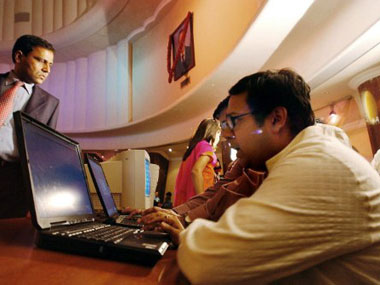Equity and bond markets were hoping that the RBI would give them a cause to cheer this Diwali. However, the central bank put paid to that hopes as it cut the CRR (Cash Reserve Ratio) by a token 25 bps and guided for any action on the repo rate only in January 2013.
The RBI also threw water on hopes of the economy coming out of a rut by guiding for GDP growth at 5.8 percent for 2012-13, which was revised downwards from earlier projections of 6.5 percent. It also upped inflation estimates for end March 2013 to 7.5 percent from previous projections of 7 percent.
[caption id=“attachment_508003” align=“alignleft” width=“380”]  Markets can now only look forward to a festive Holi season, with Diwali being a washout.[/caption]
The equity and bonds markets’ reaction to the RBI policy review is understandably negative with the Sensex and Nifty down by around a percent post policy and the yield on the benchmark ten-year bond (8.15% 2022) up around 4 basis points.
The markets have nothing to cheer about going forward and will continue to languish until the beginning of 2013 where expectations of rate cuts will start getting priced in to equity and bond levels.
The Indian rupee (INR) too lost ground post policy to trade at one month lows of Rs 54.16 to the USD. The INR has lost around 3.8% from highs seen in October 2012 and is likely to trade at around Rs 55 levels in the near future. INR will look to strengthen only in end 2012 or beginning 2013 on the back of rate cut expectations in January 2013.
Ironically, RBI is worried about the effects of a depreciating INR on inflation and felt that a calibrated response to growth-inflation dynamics is beneficial for the INR. The fact is that the downward revision in GDP growth projections and upward revision in inflation estimates are rendering a negative outlook for the INR in the near term.
The RBI has reduced its monetary aggregates target for fiscal 2012-13 with growth of broad money supply (M3), bank deposits and bank credit placed at 14 percent, 15 percent and 16 percent, respectively, down from levels of 15 percent, 16 percent and 17 percent targeted in the April 2012 policy setting.
The lowering of growth targets of monetary aggregates is in line with the lowering of GDP growth forecast from 6.5 percent to 5.8 percent. M3, bank deposit and bank credit growth are trending at levels of 13.3 percent, 13.9 percent and 15.9 percent, respectively, as of 5 October.
The 25bps CRR cut will lead to a liquidity infusion of Rs 17,500 crore into the system. The banking system is drawing down funds of around Rs 85,000 crore on a daily average basis from the RBI’s liquidity adjustment facility window to meet its daily liquidity requirements. An injection of Rs 17,500 crore through a CRR cut will not help bring down liquidity deficit by a wide margin.
The question now being asked by the markets is when will this situation of slowing growth and rising inflation reverse? The RBI has been consistently revising growth estimates down over the last one year and has consistently been behind inflation over the same period.
More importantly, the RBI is not being positive on either growth stabilising or inflation stabilizing and markets will be wondering if growth and inflation will stabilize at all.
RBI actions are not conducive to either inflation coming off or growth taking off. RBI last cut the repo rate in April 2012, where it cut the policy rate by 50bps.
The central bank has lowered CRR by 50bps over the last two months. RBI has also bought government bonds worth Rs 80,000 crore in the first few months of fiscal 2012-13. RBI’s actions are definitely not inflation friendly.
The fact that liquidity has consistently been in deficit for the first seven months of 2012-13 and the fact that economic growth forecast is being revised down suggest that RBI ’s policies have not done enough for growth. The RBI looks to be sitting on a fence and not taking a decisive call on which way it should go.
Markets can now only look forward to a festive Holi season, with Diwali being a washout.


)
)
)
)
)
)
)
)
)



